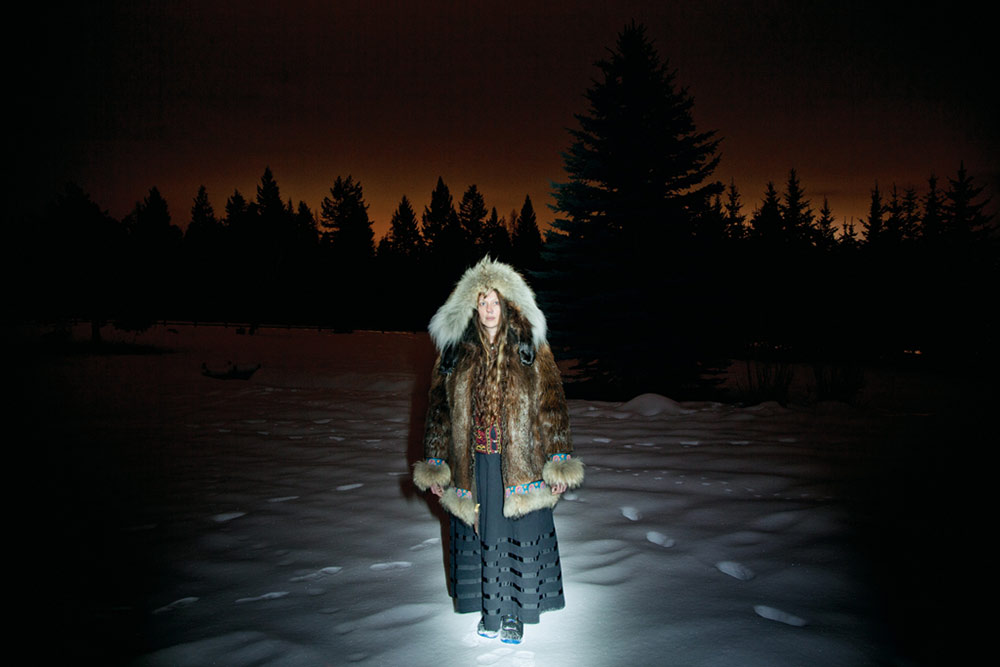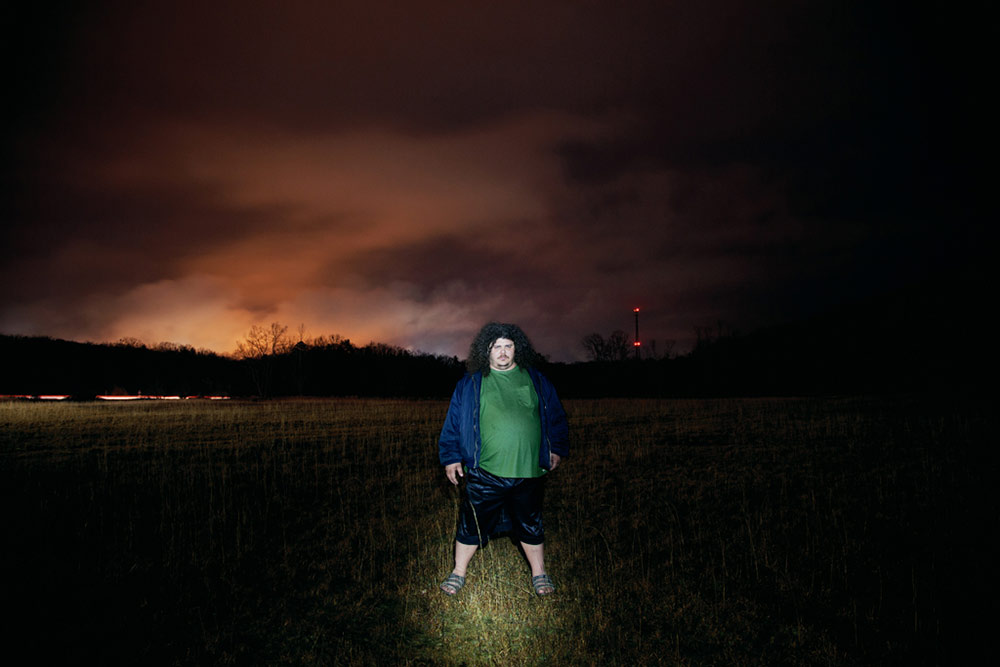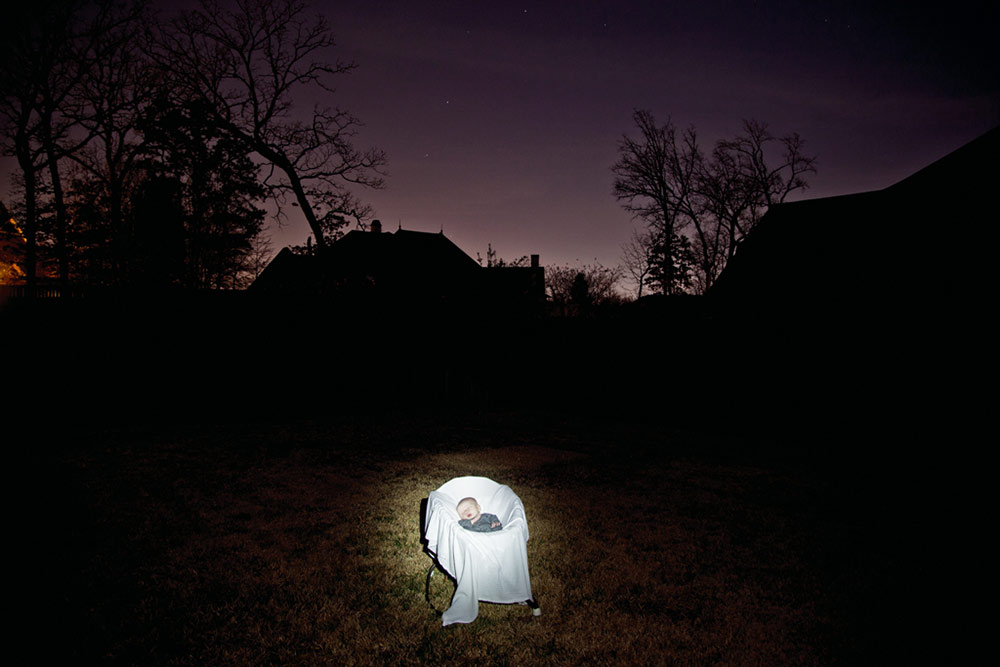How did you develop the concept for this new series, and why is linking yourself to these distant relatives interesting to you?
Two years ago, I took a DNA test in order to discover information about my maternal side. There are websites where you can correspond with strangers who share DNA with you. I began to contact and correspond with those distant relatives, in order to begin to build a sort of "family album" of portraits of people who I am distantly related to. I wanted to meet these strangers, who I also happen to be related to.
How do you relate your work to the large body of feminist photography and video art?
That's a giant question, worthy of someones MFA thesis. I'll just say, that I am a feminist and am happy to be included in any way in the larger body of feminist art history. Oh, and I was interested to to find out, while shooting portraits for this new series, that the Puritain, feminist leader, Anne Hutchinson is my eleventh great-grandmother.
Your work has a sort of tenderness to it, commenting on and expressing a loneliness present in our society. In what way does your new show further develop that theme?
I think that this body of work not only speaks about the person in each photograph, but the distance between that person and myself. In some images, that psychological space seems small, and in others, it seems impossibly large. I think that this work also speaks about America in 2013, and that it is seeped in the feeling of being alone in the middle of America, while still trying so hard to make connections with other people. I was interested in travelling across America, interested in spending time in the middle of nowhere, while looking for distant family. I wanted to meet each distant relative at night, in remote locations, and light each image only with starlight, moonlight and flashlight, in order to make isolated portraits of each person. I think there is something profound and also lonely about a single person standing in a frame. There is also something very optimistic about that single person, a sort of "I'm here to see you, and I'm here to be seen" feeling about them. I think the portraits and also the subjects in the portraits are vulnerable and also brave.

Kalispell, Montana
How does Relations reflect your your overall theme of connectivity between strangers, and how is it different from your earlier work?
I think that Relations is very connected to my early work in feeling and ambition. My work has always been about trying to connect with strangers, trying to record those meetings and trying to speak about how we as humans try to find a place to fit in. In my early work, I was physically in each image, in this new body of work, I am in each image through the tiny bits of DNA that I share with each stranger. In many ways, they are modern day self-portraits.
Do you have specific environments where you would like your work to be viewed? If someone wanted to watch your videos on their phone, would you object?
I've make this body of work to be seen in a gallery or museum setting, but I wouldn't object to someone getting to know the work as images on a computer or screen. That said, I don't want my early videos online. Most of those early videos were made pre Youtube, so I feel that they shouldn't be confused with videos we might find on Youtube. I think it's important to remember the context in which each piece was made, and for each piece to live within the original context. I'm a big fan of Youtube, but I am happy not to put my art in a Youtube setting. I think it would be an interesting challenge though, to make a body of work specifically for a youtube audience.
Have you maintained personal connections with any of these strangers whom you have met and filmed? How was your experience different when photographing distant relatives than other subjects?
I've formed and maintained friendships with many people, in all of my series. When I meet someone I connect with, it doesn't matter to me where or how I met them. I'm just grateful that we are no longer strangers and that they were generous enough to meet me.

Gainesville, Georgia
For the upcoming event at MoMA PS1, An Open Confession, you ask the public to confess and apologize for personal shameful acts. How did you develop this concept?
That performance was to celebrate the publication of my book, 365 Days: A Catalogue of Tears, which just came out in America. It is a book which documents a year long performance in which I forced myself to cry each day, for a year. I began the project because I wanted to push back against the fact that so many people on social networking sites, like Facebook, pretend to be happy, when they really are not. I wanted to push back against this notion that we only share happy news. So, for the book launch, I wanted to ask for confessions, in order to allow people to speak about real things, which might perhaps bee hard to speak about.
Do you see your career diverging at this point, between your gallery photography and your feature film work? How does medium affect your process?
I think it's possible to continue to make both art and films; some stories need to be videos, some films and some photographs. The stories find the form that they need to find, and that is why there is no reason to try to control a set direction.
What was the most fascinating moment from this new project? What photograph from "Relations" holds the most significance to you?
In many ways, it was the whole project - the documenting of each and also all of the distant relatives. The feeling of meeting and looking into the eyes of all these strangers, who also happen to be related to me. For that reason, each image is important to me. I always knew that this project needed to be photo, and not video based. Each photo needed to represent the first moments of meeting that person. Only a photo could show the importance, and profound weight of that meeting. While I was making the work, I kept thinking about the importance of single images we have of some of our relatives, and how important those images grow to be in our familial histories. As I made the portraits in this series, I often felt that I was making records, gathering information, working very hard to record a life before it receded from my view, travelled far from the spot we met, and then one day, perhaps would disappear.

Tyler, Texas
Read more about Relations at the Leslie Tonkonow Gallery HERE
Laurel Nakadate

